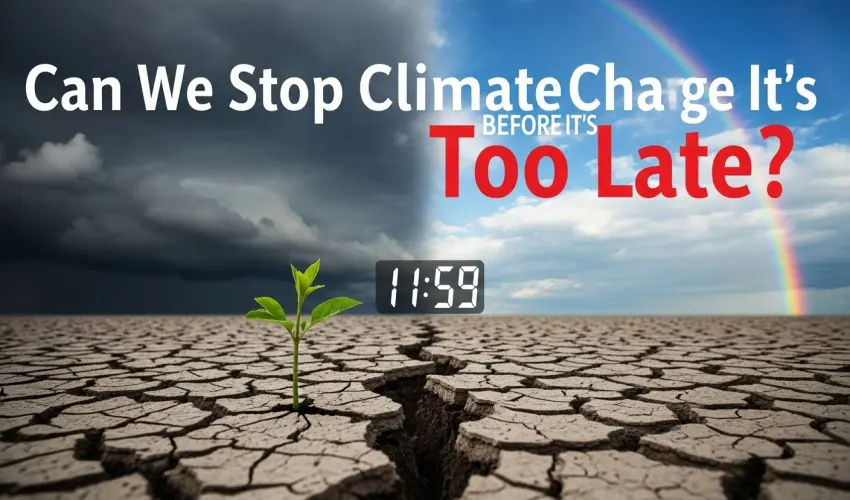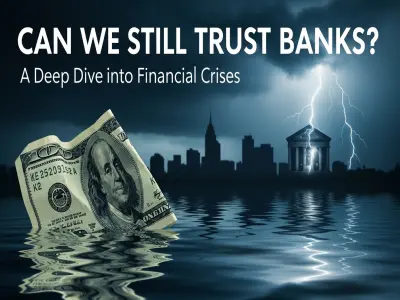Can We Stop Climate Change Before It’s Too Late?
Published Mar 20, 2025
1 0
Key Takeaways
-
Climate change is accelerating due to human activity, particularly carbon emissions, deforestation, and unsustainable consumption.
-
Science shows we have a limited time—roughly until 2030—to significantly cut emissions and prevent catastrophic warming.
-
Solutions exist: renewable energy, reforestation, carbon capture, sustainable agriculture, and systemic policy reform.
-
Global cooperation, political will, and individual lifestyle changes are critical to achieving climate goals.
-
While we can’t reverse all damage, we can still prevent the worst-case scenarios if we act fast, boldly, and collectively.
Introduction: The Question That Defines Our Generation
The planet is warming. Ice caps are melting. Oceans are rising. Forests are burning. Each year brings more devastating, impossible-to-deny evidence of climate change. As wildfires rage and hurricanes churn, one question looms over humanity like a darkening cloud: Can we stop this before it's too late?
The answer is complex. We cannot prevent climate change entirely, as some effects are already locked in. However, we can still prevent it from escalating into a full-blown, irreversible disaster. The window of opportunity is closing quickly, but it’s not shut yet.
The Science of Climate Change: What's Happening?
Climate change refers to the long-term shifts in temperature and weather patterns on Earth. While some of these changes are natural, the current crisis is driven by the massive increase in greenhouse gases (GHGs) like Carbon Dioxide (CO₂), Methane (CH₄), and Nitrous Oxide (N₂O). These gases trap heat in the atmosphere, causing the planet to warm.
The Primary Causes:
-
Burning Fossil Fuels: The use of coal, oil, and gas for energy and transportation is the largest source of emissions.
-
Deforestation: Cutting down forests removes a critical natural carbon sink.
-
Industrial Farming: Livestock, fertilizers, and land use contribute significantly to methane and nitrous oxide emissions.
-
Mass Consumption and Waste: The production, transport, and disposal of goods create a massive carbon footprint.
The Intergovernmental Panel on Climate Change (IPCC) reports that average global temperatures have already risen by 1.1°C since pre-industrial times, and we’re on track to surpass the critical 1.5°C threshold by 2030 unless urgent action is taken.
Why the 1.5°C Threshold Matters
A degree or two may not sound like much, but in planetary terms, it's a monumental shift. Exceeding 1.5°C of warming could trigger catastrophic and irreversible tipping points, including:
-
Mass coral bleaching and the collapse of ocean ecosystems.
-
Uninhabitable heatwaves across equatorial regions.
-
Widespread crop failures and global food shortages.
-
The melting of ice sheets, leading to severe sea-level rise and displacing millions.
-
Extreme weather events becoming the norm, not the exception.
Every tenth of a degree matters. Beyond 2°C, climate change becomes dangerously self-perpetuating, setting off feedback loops that even the best technology cannot undo.
Where We Stand: The Climate Clock is Ticking
Currently, humanity is emitting around 36 billion tons of CO₂ annually. To limit warming to 1.5°C, global emissions must be cut by nearly 50% by 2030 and reach net zero by 2050.
Unfortunately, current national pledges, even if fully met, would still lead to 2.5–2.9°C of warming by 2100. We are on a collision course with disaster, but the IPCC emphasizes that the future isn’t set in stone. Every year, every policy, and every decision matters.
The Solutions: Our Toolkit for a Livable Future
Thankfully, we already have the tools and technologies needed to drastically reduce emissions.
1. Transition to Renewable Energy
-
Expand solar, wind, geothermal, and hydroelectric power.
-
Shut down coal-fired power plants.
-
Electrify transportation with EVs and public transit.
-
Invest in green hydrogen and battery storage.
2. Reforestation and Nature-Based Solutions
-
Halt deforestation in the Amazon, Congo, and Southeast Asia.
-
Restore degraded lands through mass tree-planting initiatives.
-
Protect vital ecosystems like mangroves, peatlands, and wetlands.
3. Sustainable Agriculture and Food Systems
-
Shift toward more plant-based diets.
-
Reduce food waste, which accounts for up to 10% of global emissions.
-
Use precision farming to minimize fertilizer overuse and support regenerative agriculture.
4. Carbon Pricing and Political Action
-
Implement carbon taxes and cap-and-trade systems to incentivize clean business practices.
-
Phase out fossil fuel subsidies (which still total over $500 billion annually).
-
Enforce strict emissions regulations and support clean tech innovation through binding climate laws.
5. Carbon Capture and Geoengineering (Cautiously)
-
For hard-to-abate emissions, technologies like Direct Air Capture (DAC) may help. However, they are expensive, energy-intensive, and unproven at scale. They are a supporting tool, not a silver bullet.
The Power of Individual Action
While systemic change is essential, individual choices create collective impact. You can:
-
Reduce your meat and dairy consumption.
-
Drive less, walk more, or switch to an electric vehicle.
-
Use energy-efficient appliances and improve home insulation.
-
Fly less or offset your travel emissions.
-
Support green policies and vote for climate-conscious leaders.
Barriers to Progress: Why Aren’t We Moving Faster?
-
Fossil Fuel Lobbying: Powerful industry groups continue to fund misinformation and lobby against green regulations.
-
Political Inaction: Many governments prioritize short-term economic gains over long-term planetary health.
-
Economic Inequality: Developing nations require energy to grow, and climate justice demands that wealthy countries help fund their transition to clean energy.
Signs of Hope: Progress is Happening
Despite the challenges, there is a growing wave of momentum:
-
Over 70 countries have pledged net-zero emissions targets.
-
The EU Green Deal aims to make Europe climate-neutral by 2050.
-
Youth-led movements like Fridays for Future have inspired millions to demand action.
-
Renewable energy is now the cheapest form of new electricity in most of the world and is breaking installation records year after year.
Conclusion: The Future Is Still in Our Hands
So, can we stop climate change before it’s too late? Yes, but only if we act now, at scale, and with courage.
We cannot undo all the damage, but we can still prevent the most devastating outcomes. We can still choose a future where our children inherit a livable planet. This is our defining challenge and also our greatest opportunity to innovate, collaborate, and redefine what progress truly means. The clock is ticking, but the story isn’t over yet.








